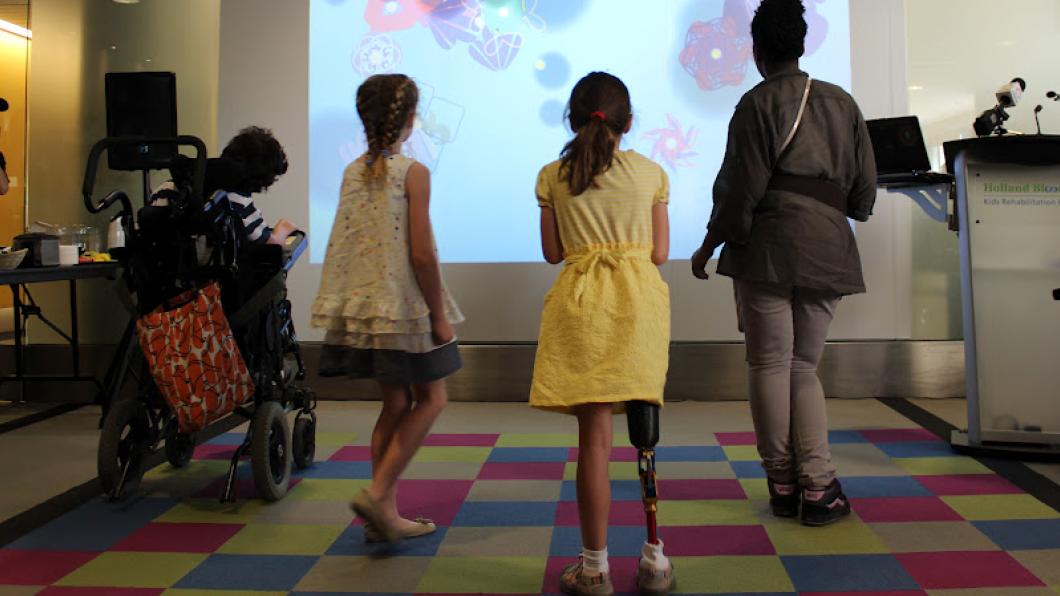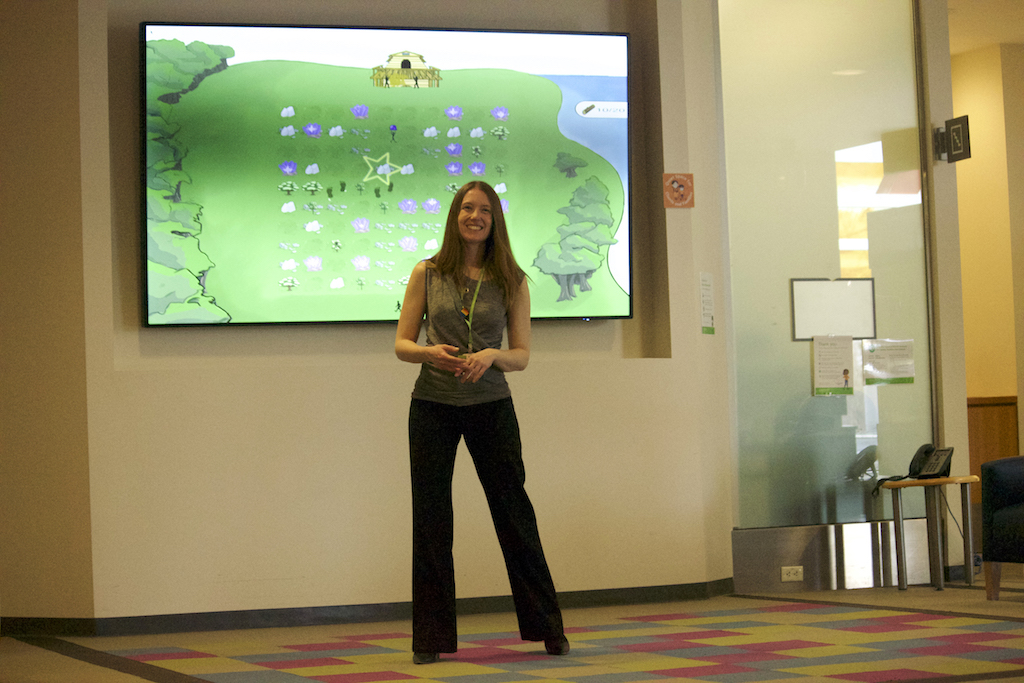
Children's rehab can be boring. This scientist aims to make it fun
By Louise Kinross
Once a day, Elaine Biddiss walks by the outpatient waiting room at Holland Bloorview. If she sees a child or two playing on the coloured floor tiles while looking up at the giant screen, her heart flips. Sit or stand on a tile, or wheel your chair over it, and images grow on the screen. "The longer you stay in one spot, the more happens," says the senior scientist, who developed the ScreenPlay technology to reduce waiting-room jitters for children. "We wanted kids who have less mobility to have the maximum impact on the environment, which can be opposite to what normally happens in life." Elaine joined Holland Bloorview in 2008 after doing her PhD in mechanical engineering here. She now directs our PEARL Lab. We spoke about the joys and challenges of her role and what make a great researcher.
BLOOM: How did you get into this field?
Elaine Biddiss: In high school I loved every subject really. I think I chose engineering at university because one, it was probably where I felt I had the most to learn and the problem solving really appealed to me, and two, I followed my brother when I went into mechanical engineering at the University of Toronto. He was sort of my idol growing up. My parents didn't have the opportunity to go to university and my brother and I were first-generation university-goers. Education was super important to my parents and they have always been my champions.
In my fourth year I had a couple of aha moments. One was during a biomechanics class where we came to Bloorview on a tour and I met Tom Chau. I remember seeing the virtual music instrument and that probably stood out the most for me. I play piano and music has always played a very important part in my life. That opening up of possibilities for any child to enjoy music was very inspiring. It was also super innovative at that time.
BLOOM: Did you have any experience with disability?
Elaine Biddiss: My only experience was with my grandmother, who had a severe stroke when I was in Grade 2. She lived in a nursing home for about 10 years, and we would go to visit her every weekend. She was a beautiful woman. She couldn't talk and she could only move one hand, but she could communicate so much through her eyes. She had the sparkliest eyes that would light up when she saw you. She brought so much light into people's lives.
I think what drew me to working with kids with disabilities was trying to, in my small way, give them the opportunities to do everything that they want to do, and everything that every kid should have the opportunity to do.
Our lab is called PEARL, which stands for Possibility Engineering and Research Lab. I liked the imagery of every child being a pearl that grows, and it grows because of the environment that is around it. There's both the focus on the child as a beautiful individual that is a unique person, and the environment that helps them grow into who they are.
BLOOM: How would you describe your research?
Elaine Biddiss: Our main focus is the design of technologies, most often apps and video games, that all kids can use for wellness and learning and play. I had no interest in video games personally, but when I started here, in talking to kids, parents and clinicians, it was very apparent that they were interested in using movement-tracking games to motivate boring therapies. That really appealed to me. These kids have this extra layer of stuff they have to do on top of everything else, so it seemed to me that we had a responsibility to make therapy as fun and meaningful as possible.
BLOOM: Can you describe one of these games?
Elaine Biddiss: Bootle Blast is a movement-tracking video game for children working on upper motor skills that's been used in clinics here since 2017. It uses mixed reality, where real-life objects are used in gameplay, to target fine-motor skills that kids need to practice. In a 12-week study where kids used it at home, children improved both in their perception of achieving goals that are important to them, such as as tying their shoe laces, cutting meat with a knife, and using a computer, and on traditional outcome measures for quality of hand and arm movement and use of both hands.
We're recruiting for a study of 60 kids with diverse disabilities who will use the game at home in urban and rural settings in Canada and in Costa Rica.
BLOOM: What is the game about?
Elaine Biddiss: It's about a robot named Botley who lives in Sky Spark City. He doesn't like doing chores and he invents a Bootle Bot to help him with his chores. One works out really great, so he uses his replicator machine to make more. He's clumsy and replicates too many and Bootles are running amok in Sky Spark City. It's the players' job to help round them up. Some develop hobbies and personalities. So there are scuba-diving Bootles and chef Bootles. Through playing mini-games that target specific therapy movements calibrated to each child's abilities and goals, they can buy stuff to keep the Bootles happy. It's a multi-player game, so kids can play with their friends, siblings or parents.
BLOOM: Who came up with the amazing storyline?
Elaine Biddiss: It was a dream-come-true student called Maritza. I remember getting her purple CV on my desk. She had an undergrad in psychology and worked as a nanny for a child with severe cerebral palsy and she went to this kid's media design program, so she had a confluence of expertise.
BLOOM: What is a typical day like for you?
Elaine Biddiss: There's a lot of thinking, a lot of staring at walls trying to think about solutions to various problems. Often I'm thinking about study design, or how we evaluate the different technologies, or how to overcome challenges that present themselves in research. Walking is very helpful.
BLOOM: Do you walk in the ravine behind the hospital?
Elaine Biddiss. I do. I think that feeling of movement in your body helps your brain make movement and not stagnate.
Part of my day is meeting with my students. I see my role as a guide in their journey to learn how to do research, which is basically how to come up with a question and how to answer it. You don't train a student by telling them exactly what to do, they have to do the problem solving. So it's letting them make mistakes in the same way I make mistakes, and being okay with that.
I think the hardest thing for students is that they want to create a big world impact fast. But research and design are such iterative processes and it takes so long to get it right. Getting through one cycle of trying to empathize with and understand the problem, ideating and figuring out some solution, prototyping and evaluating it, and understanding what's wrong with it, so you can start all over again, can take years.
When it's grant-writing season, that's all absorbing. I also spend time on a start-up we're creating called Pearl Interactives, which will get some of these technologies out as products families can buy.
BLOOM: What's the greatest challenge of your work?
Elaine Biddiss: I guess it's the uncertainty of everything. You have to have a thick skin to do research, because you're going to get rejected all the time. We're so reliant on grants. Even when you've put one together and justified the budget, you'll get the grant, but it will come back with the budget cut by 30 per cent. So you're trying to do a project with only 70 per cent of the money. Then suddenly you need to find students to work on the grant, but you can't always find the right students at the right time. There are so many ingredients and a lot of conflicting variables. That's why you have to focus on your North Star, helping kids with disabilities, and let the other stuff wash over you.
BLOOM: What do you do to manage stress?
Elaine Biddiss: Walking and yoga with an app I can use at home. And a sense of humour.
BLOOM: What emotions come with the job?
Elaine Biddiss: The whole spectrum. Joy and excitement and curiosity and love, because I love my job. From that to severe rejection and disappointment and uncertainty and fear. Can I do my job given all of these complications? Worry and impatience, because things don't happen as fast as I want them to.
BLOOM: What qualities do you need to be a great applied researcher?
Elaine Biddiss: Persistence. You have to be stubborn. But not stubborn in a 'This is the only way I'm going to do it' way. You have to keep at it, while also being adaptable. You're always going towards the North Star, but okay, I was going to take the straight road and now I'm going to take a boat tour here and a gondola up here, but I'm still going there. Resilience, to manage all of the frustrations and rejections. My support network for work things is at work, with the people who get it. My team is amazing and it's that sharing of struggles that helps you cope.
BLOOM: If you could change one thing about children's rehab research, what would it be?
Elaine Biddiss: It would be getting products out there faster. When we create things I want kids to be able to use them. It would be easy to say we need more funding, but we live in a realistic world. I think the answer has to be better collaboration between families, clinicians, researchers, game designers and people who commercialize products early on, and throughout the process.
BLOOM: What advice would you give a researcher just starting out?
Elaine Biddiss: Talk to people, but more importantly, listen to people. Respond to needs. Don't come with your own problems that are interesting to you. Engineers are great at solving problems, but we don't necessarily have a clue what the problem is. So be really open and don't get attached to any idea. If someone tries to redirect you, make sure you're listening. Understand the problem first, without preconceptions of what you want the solution to be.
The other thing is to find your North Star, the impact you want to have, and stay clear on it. It's important not to get caught up in the daily struggles. Walking past ScreenPlay is my daily reminder. When you see a child experiencing something they haven't experienced before, or finding amusement or joy or curiosity, that makes it all worth it.
Check out videos of Elaine's games at Pearl Interactives. To reach out about participating in research, e-mail ebiddiss@hollandbloorview.ca. Like this interview? Sign up for our monthly BLOOM e-letter: https://bit.ly/3xfj4jc.
